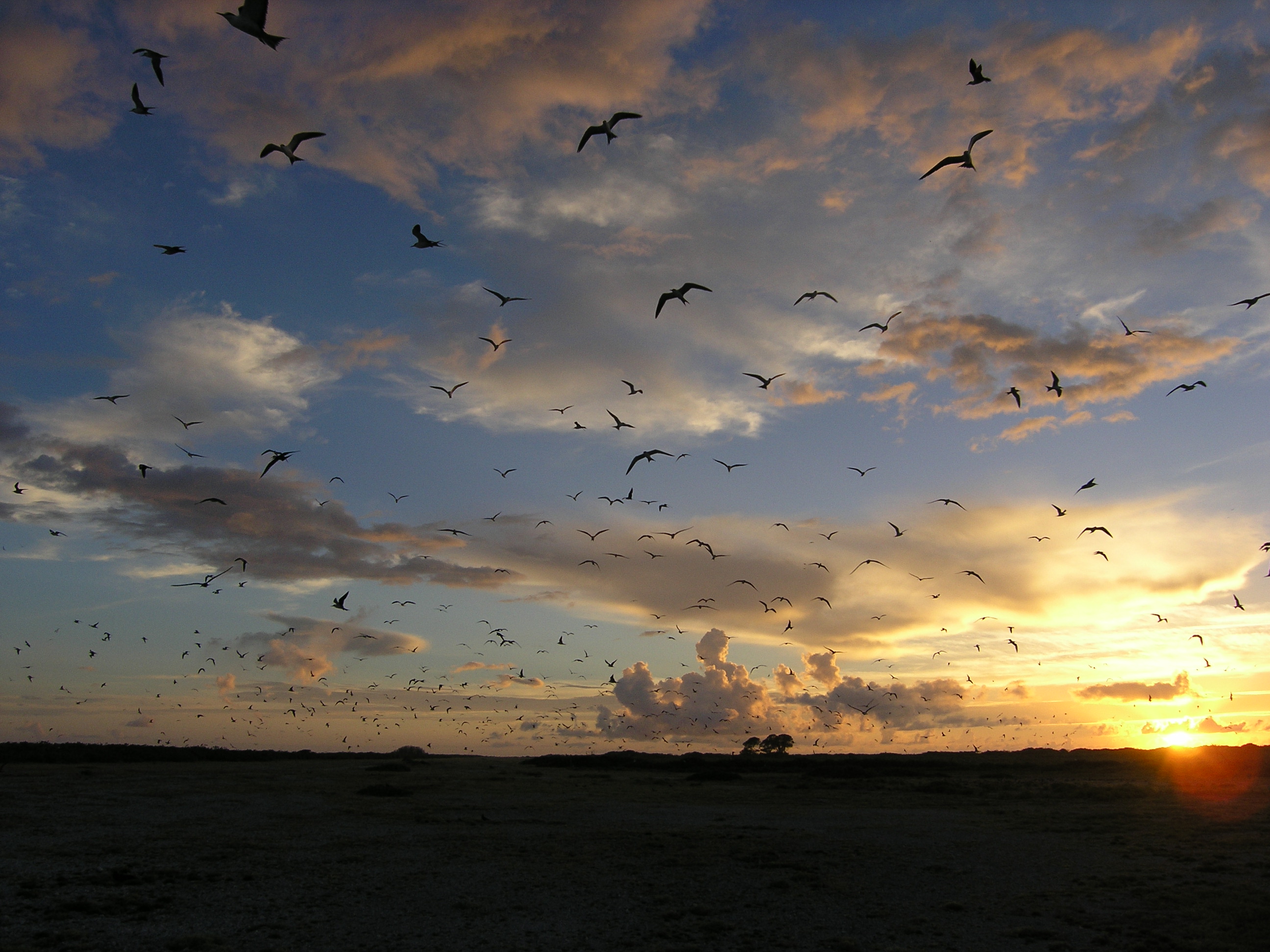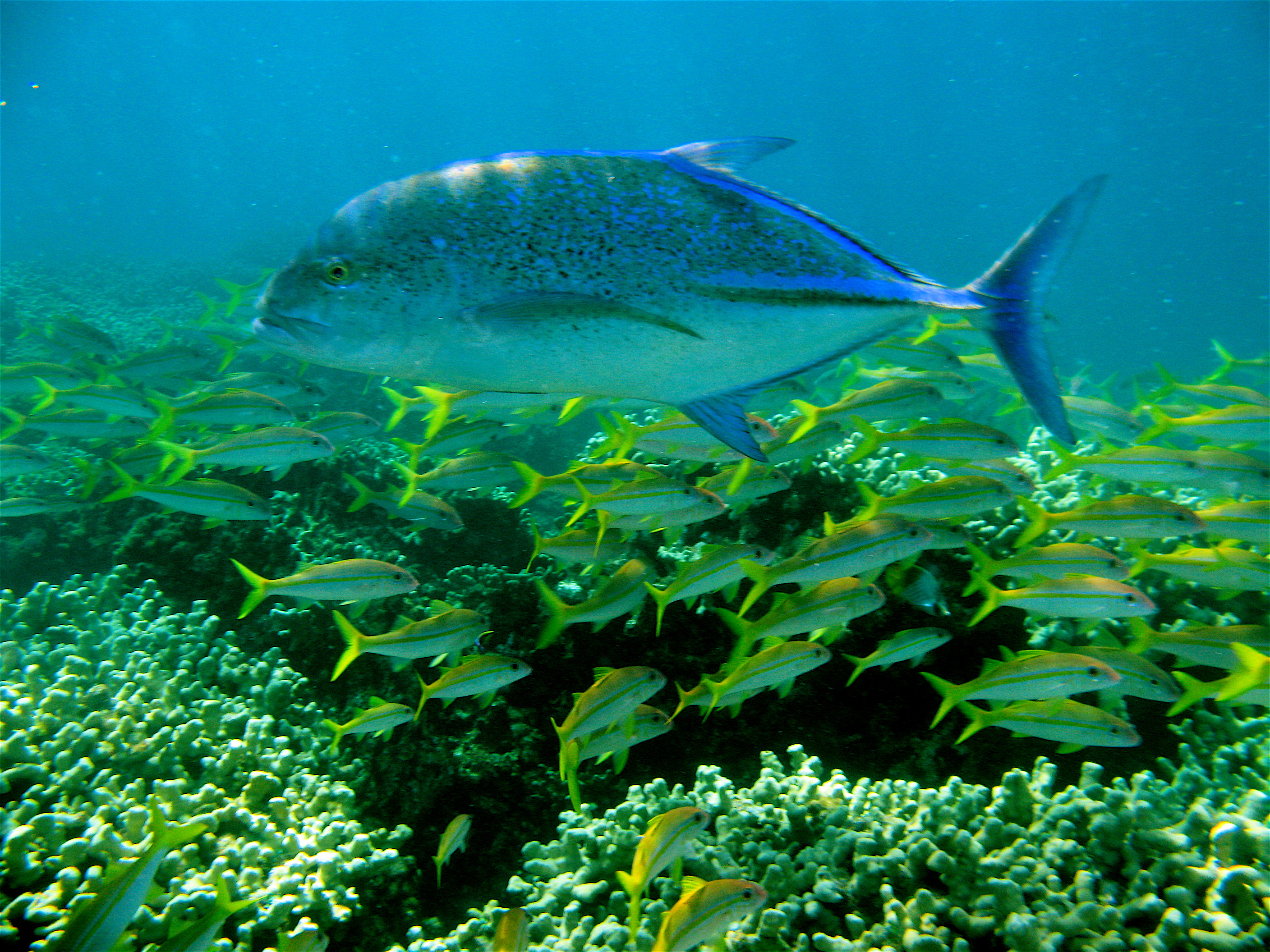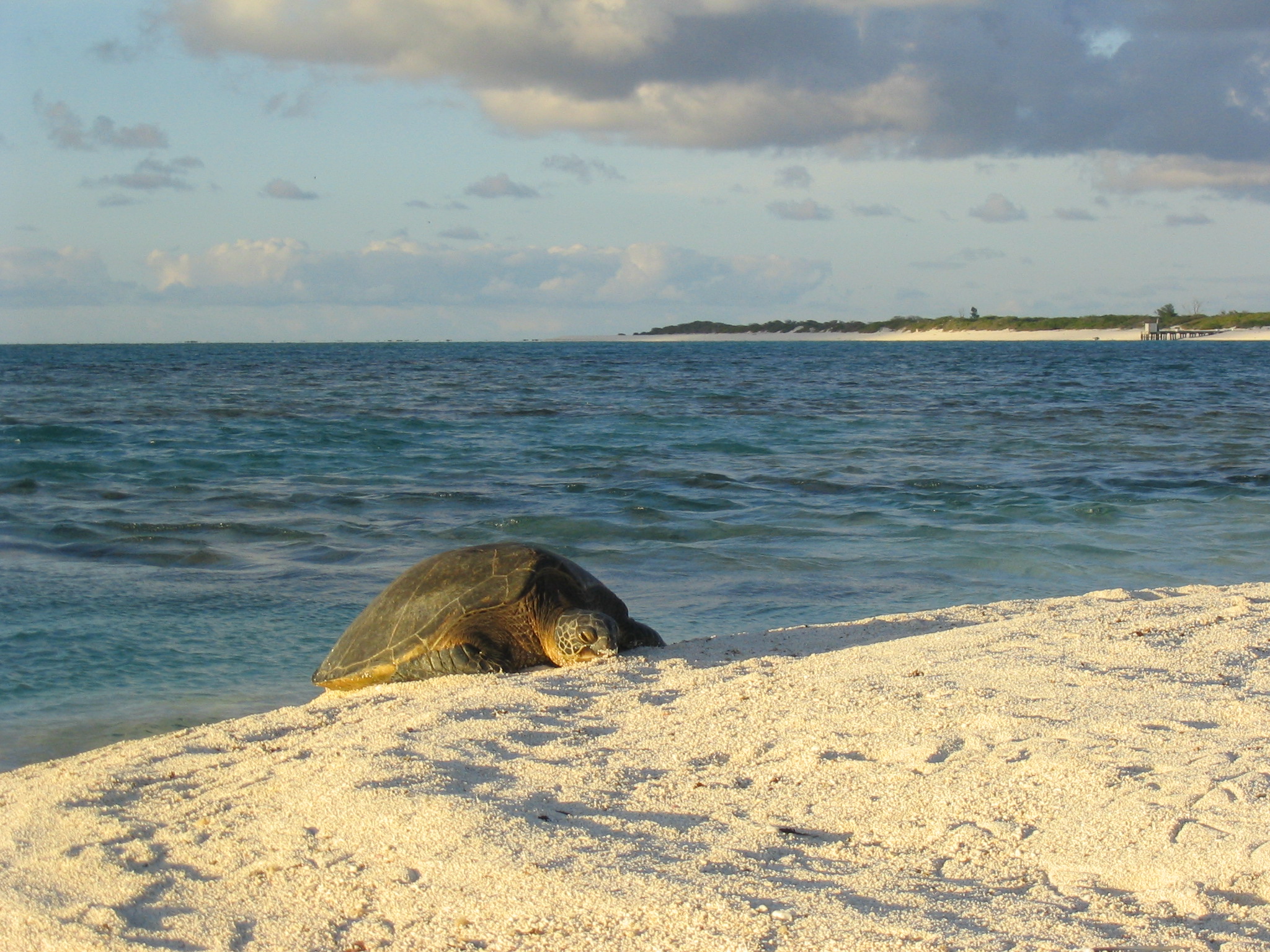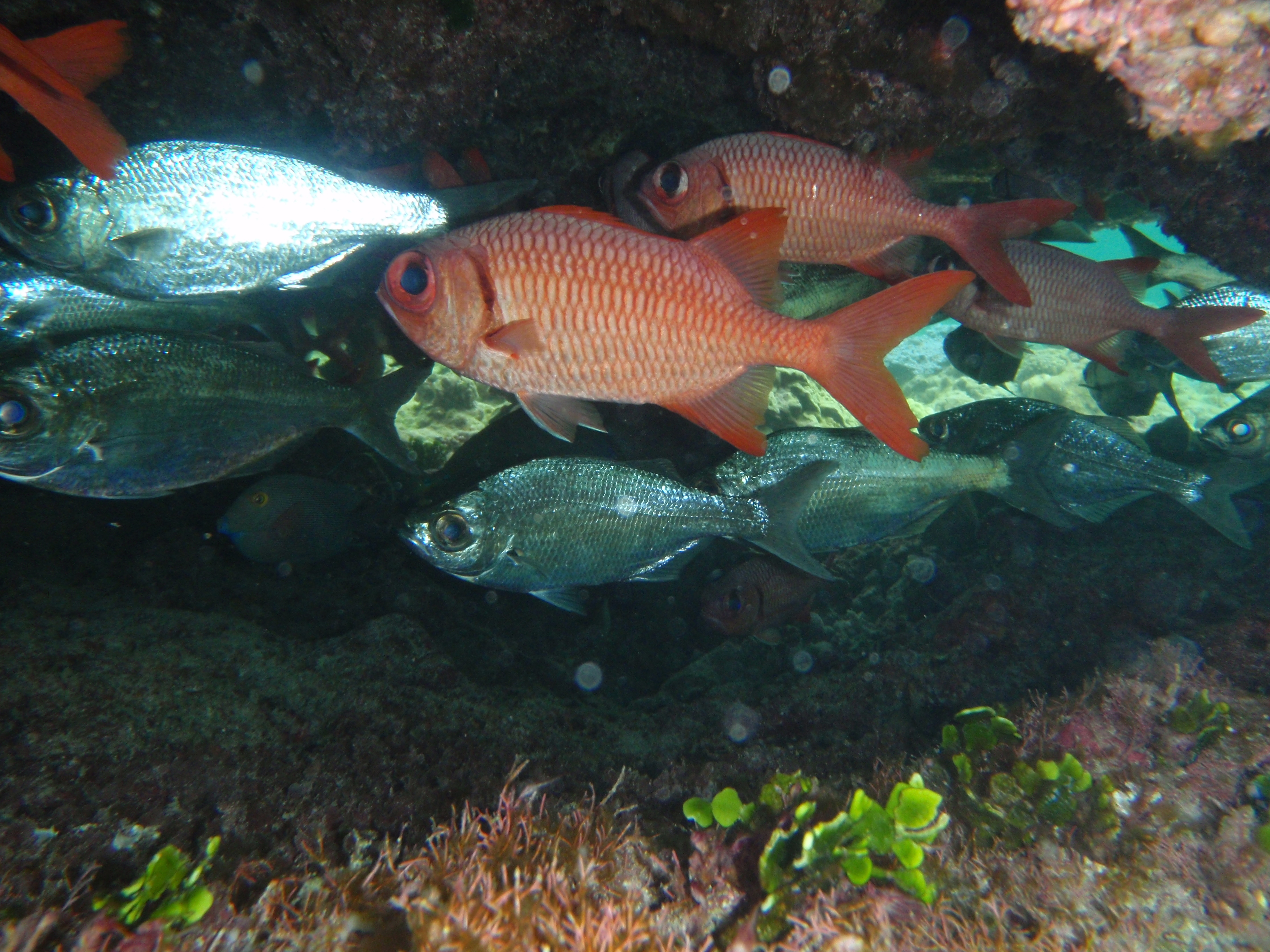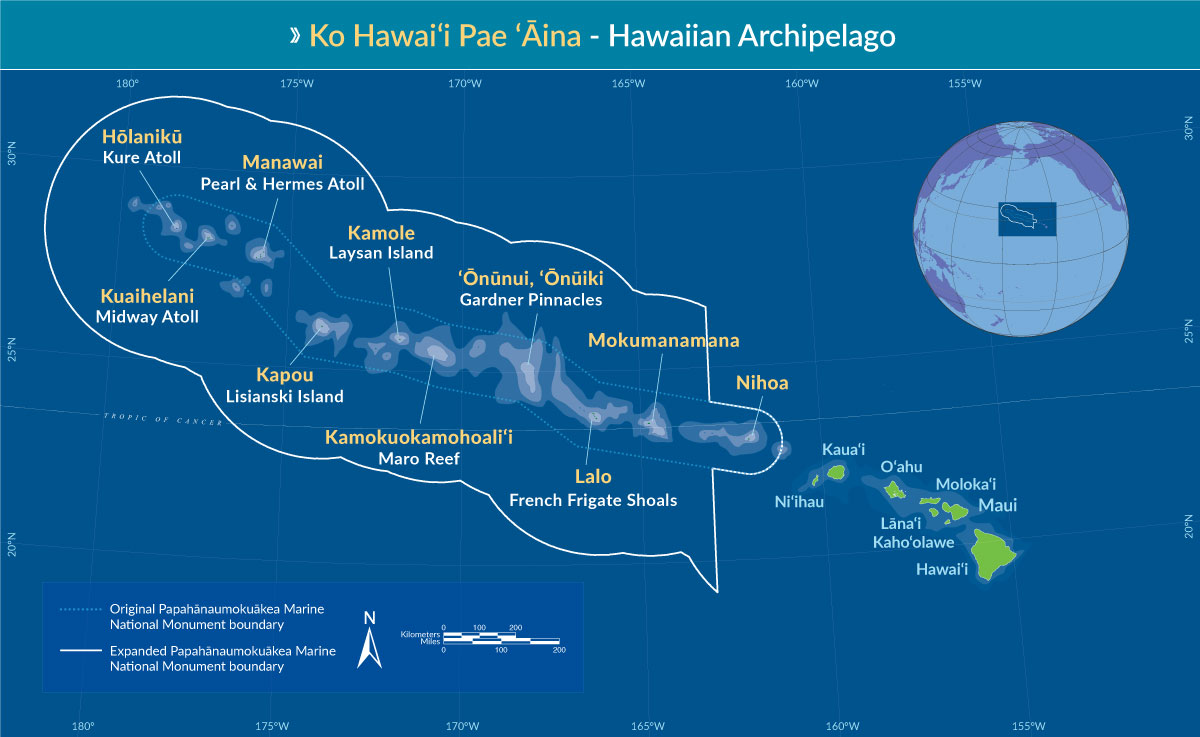Northwestern Hawaiian Islands Fisheries
Fishing in Hawaii has roots in the many different cultures and ethnicities that make up the island communities. Native Hawaiians depended on ocean resources across the archipelago for both sustenance and to practice their culture. The fishery resources in the NWHI are held in high regard. Historically, the Council has managed lobster and bottomfish fisheries, and enacted protected species zones, among other management measures. The NWHI fishery resources have played a vital role in the culture and economy of Hawaii.
About
History of the Fisheries in the Northwestern Hawaiian Islands
500–1500 AD Polynesians migrate to Hawaii. According to legend, the chiefess Pele and her family first land at Mokupapapa, a flat reef-like island, where her brother Kanenilohai is left. The next island is Nihoa, where her brothers Kaneapua and Kamohoalii (the shark god) are left. A study of Nihoa and Moku Manamana (Necker Island) in the 1920s uncovers numerous shrines and a fishhook of the type used with a kaka rig to fish in the kialoa (deep waters) for bottomfish. Carbon-dating indicates the islands were settled about 1000 AD.
1700s–1800s Native Hawaiians from Kauai and Niihau make regular canoe trips to Mokupapapa, an island west of Kaula, for turtles and seabirds. Nihoa is occupied each summer by Native Hawaiians until the late 1800s. Olona fiber fishing lines of 300-foot length suggest bottomfish fishing took place as several of the lines could be tied together.
Read More
1910–40s In 1917, public officials deny requests to establish a fishing station and cannery at French Frigate Shoals (FFS). Daikoku Maru nets inshore species in the shoal until it is lost at sea in the 1920s. In the 1930s, Katsuren Maru fishes for inshore species and turtles as far as Maro Reef and Lanikai and Islander fish throughout the NWHI for pearl oysters, ulua, mullet, weke, akule, lobster from the reefs and shoals and onaga, uku, ehu, opakapaka and hapuupuu from the deep seas. Lanikai establishes a fishing station at Pearl and Hermes Reef. Reliable nets inshore species and captures turtles in the mid 1940s. Simba is a mothership for three to four smaller sampans fishing for akule, moi, weke, lobsters, turtles and other inshore species. Capt. Jake Hoapai and 11 crewmembers are lost at sea in the late 1940s.
1940–44 World War II leads to the development of a US Navy base at Midway Atoll. At FFS, the 11-acre Tern Island is converted into a 42-acre naval airstrip. A Coast Guard LORAN station is established at East Island, FFS.
1946–59 Nine large commercial vessels fish the NWHI. By 1946, two fishing bases at Tern Island airship trapped fish and turtles to Honolulu. The Pacific Oceanic Fishery Investigation in 1948 begins research of potential commercial fishery yield. In 1950, Leo Ohai, owner and captain of Sea Queen, transports a small aircraft to FFS to support akule fishing and Buzzy Agard flies catches in a DC-3 cargo aircraft from FFS to Honolulu and captains Koyo Maru to catch akule at Nihoa. Sea Hawk and Osprey fish Lisianski for shoal and deep-sea species. Osprey is lost at sea in the 1950s. All hands are rescued off FFS. Elaine and Brothers fish for lobster and inshore species at FFS. Koyo Maru fishes for deep-sea and inshore, shoal species and is lost at sea in the 1960s. Kaku fishes to Maro Reef for shoal and deep-sea species. Taihei Maru fishes to Lisianski for ulua from the shoals and onaga, opakapaka and other species from the deep. A limited local market causes the fishery to eventually decline.
1964 Wilderness Act is passed, prohibiting commercial enterprise within a National Wilderness Preservation System. NWHI is twice proposed to Congress as a wilderness area, but the State of Hawaii strongly opposes any prohibition of commercial fishing.
1965–77 Japanese longliners annually expend up to 2,170 vessel days in the NWHI, harvesting up to 2,204 mt of tuna and 1,260 mt of billfish. Japanese pole-and-line vessels targeting skipjack tuna, Japanese draggers for precious corals and Japanese and Soviet trawlers targeting groundfish are observed in NWHI waters. A Governor’s Task Force recognizes that fishery resources on the main islands are taxed and recommends developing NWHI fisheries. An expanded local market causes NWHI bottomfish and troll landings to increase. In 1973, National Marine Fisheries Service (NMFS) begins NWHI reconnaissance cruises. In 1976, Congress adopts the Magnuson Fishery Conservation and Management Act, establishing the Western Pacific Fishery Management Council to manage fisheries in federal waters around Hawaii and other US Pacific Islands. Foreign vessels are forced from NWHI waters.
1978 Following a Governor’s Advisory Committee recommendation, NMFS, US Fish and Wildlife Service, State of Hawaii and University of Hawaii begin a five-year cooperative research program to identify NWHI marine resources.
1980–86 The Council establishes the Precious Coral Fishery Management Plan (1980), Crustaceans FMP (1983) and Bottomfish and Seamount Groundfish FMP (1986). A Crustaceans FMP amendment creates no-take zones 20 nmi around Laysan and landward of the 10-fathom curve in all other NWHI areas.
1987–91 The Council establishes the Pelagics FMP (1987), NWHI Hoomalu Zone bottomfish limited entry program (1989) and Protected Species Zone, 50 nm around NWHI, within which longline fishing is prohibited (1991).
1995–2000 Council contractors complete Review of coral reefs around American Flag Pacific Islands and assessment of need, value and feasibility of establishing a coral reef fishery management plan for the Western Pacific Region (1995) and An assessment of the status of coral reef resources, and their patterns of use, in the US Pacific Islands (1997). The NWHI Mau Zone limited entry program is established (1999). Following public scoping hearings, the Council submits the draft Coral Reef Ecosystem FMP and preliminary draft EIS to NMFS. Preferred alternatives identify all federal waters 0–50 fathoms in the NWHI as marine protected areas and recommend 24 percent of the total NWHI as no-take zones.
2005 September 29, 2005: The State of Hawaii Governor Linda Lingle signs regulations establishing the Northwestern Hawaiian Islands Marine Refuge. The Refuge includes all state waters of the NWHI extending 3nm seaward from any coastline.
2006 June 15, 2006: President Bush created the NWHI Marine National Monument on top of the footprint of President Clinton’s NWHI Coral Reef Ecosystem Reserve using the Antiquities Act. Under the act, public process, Congressional action and scientific justification are explicitly not required. Presidential Proclamation 8031 (71 FR 36443).
2007 February 28, 2007: President Bush issues Presidential Proclamation 8112 amending Proclamation 8031 of June 15, 2006 to read “establishment of the Papahānaumokuākea Marine National Monument”; amends Additional findings for Native Hawaiian Practice Permits, 2(e), to read: Any living monument resource harvested from the monument will be consumed or utilized in the monument.
2016 August 25, 2016: President Obama issues Presidential Proclamation 9478 entitled, Papahānaumokuākea Marine National Monument Expansion creating a second Marine National Monument in the region, adjacent to the PMNM and out to the full 200nm EEZ westward from the 163◦ West Longitude.
2020 Congress includes language in the 2021 Appropriations Bill: “Papahānaumokuākea Sanctuary Designation.—The Committee directs NOAA to initiate the process under the National Marine Sanctuaries Act (16 U.S.C. 1431 et seq.) to designate the Papahānaumokuākea Marine National Monument as a National Marine Sanctuary to supplement and complement, rather than supplant, existing authorities. NOAA shall provide the Committee an update on this designation before the end of fiscal year 2021.”
2021 November 19, 2021: Office of National Marine Sanctuaries requests fishing recommendations for the Monument Expansion Area of the Northwestern Hawaiian Islands in preparation for the designation of a National Marine Sanctuary for the area. Under the National Marine Sanctuaries Act section 304(a)(5), the Council is provided the opportunity to provide fishery regulations for the sanctuary.
2023 April 14, 2023: The Council transmits final recommendations for fishing regulations to the National Ocean Service, including prohibition on commercial fishing and federal permitting and reporting requirements for non-commercial fishing and Native Hawaiian subsistence fishing activities.
Fishing in the NWHI
Fishing occurred in the NWHI in pre-contact times and continued into the 1700-1800s by the indigenous people making regular trips for turtles, seabirds, and bottomfish. In the 1800s, Western sailing ships exploited the areas for whales, seals, reef fish, turtles, sharks, pearl oysters, and sea cucumbers. The early 1900s saw the establishment of a fishing station and cannery at Lalo (French Frigate Shoals) and a fishing station at Manowai (Pearl and Hermes) while boats fished for inshore species like ulua, mullet, moi, weke, akule and lobster, as well as deeper fish like onaga. By mid-century, after World War II, large commercial vessels, including those operated by indigenous Hawaiians, began fishing and sent fish back by air from fishing stations at Tern Island. Foreign fishing fleets from Japan and the Soviet Union also start fishing in the NWHI until 1976 when the US passes the Fishery Conservation and Management Act forcing foreign fleets out of NWHI waters. In 1978, the State of Hawaii, NMFS, USFWS, and UH develop a cooperative research program to identify marine resources in the NWHI. Since then, different fisheries have operated in the NWHI until the closing of the fisheries by Presidential Proclamation.
Lobster Fishery
One resource identified in the cooperative research program was lobsters. Following research in the late 1970s under the Tripartite Cooperative Agreement (State of Hawai‘i, NMFS, and USFWS), lobsters were identified as a valuable renewable resource. Commercial harvesting began soon after, supported by scientific monitoring. The NWHI lobster fishery was a hallmark of early Council management success and later a case study in adaptive precautionary governance. It evolved rapidly under a detailed regulatory framework that balanced economic opportunity with species conservation. See our Pacific Islands Fishery Monograph for the full story on the NWHI Lobster Fishery.
Bottomfish Fishery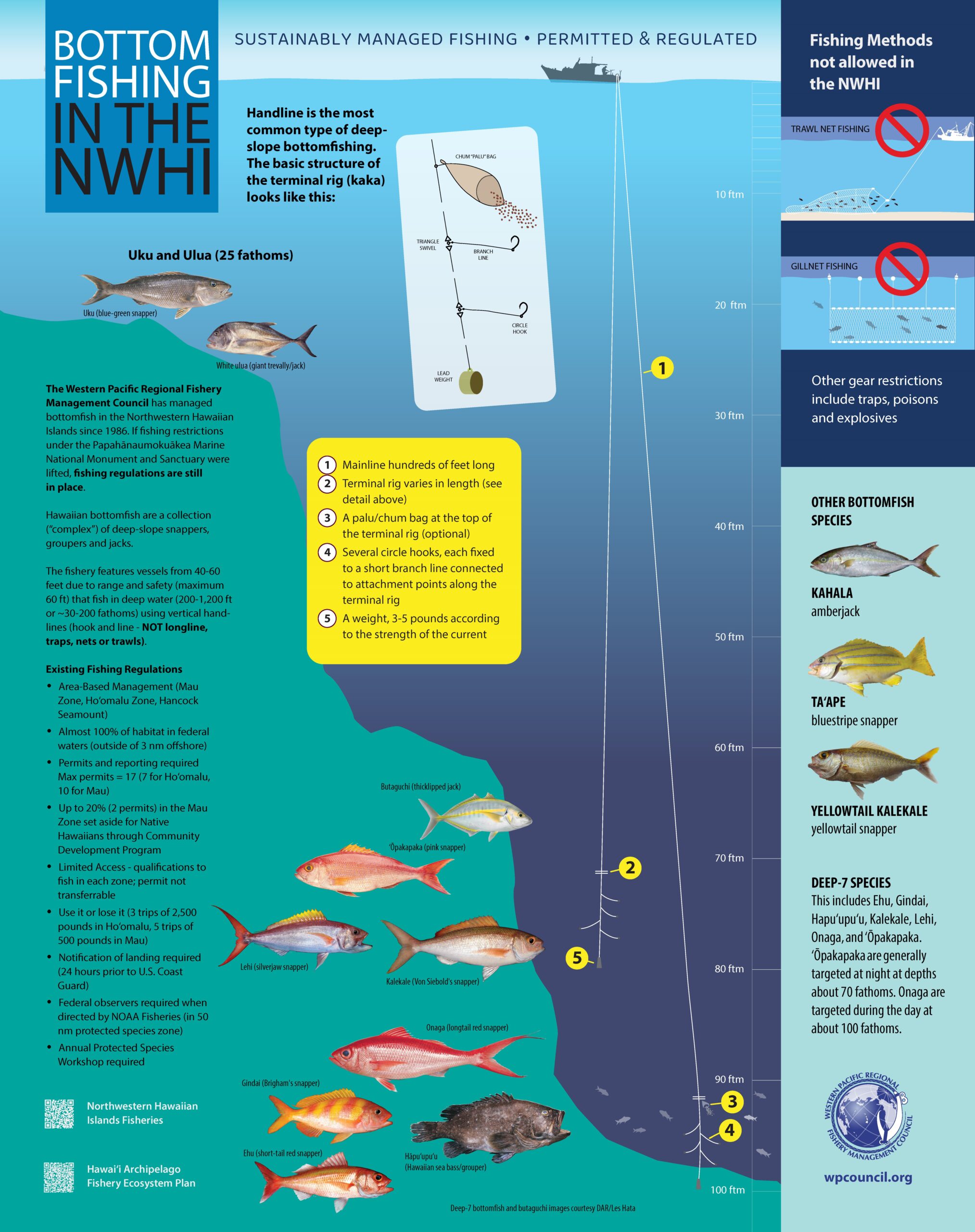
Another resource identified was the deepwater snappers and other bottomfish. The bottomfish fishery of the NWHI was among Hawai‘i’s most productive and culturally significant fisheries. It served as a cornerstone of local food systems and a model for limited-access management before being phased out for ecosystem protection. Bottomfish, especially onaga, ehu, and opakapaka, are prized in Hawaiian cuisine and hold ceremonial value. The NWHI stocks were considered healthier than those around the main Hawaiian Islands, making them vital to sustaining market demand and traditional foodways. In 2006, the designation of the Papahānaumokuākea Marine National Monument phased out the bottomfish fishery. This designation eliminated approximately 50% of Hawai‘i’s local bottomfish supply.
The diagram illustrates bottomfish gear and approximate habitats for a few of the species targeted. It also includes fishing regulations in place should restrictions under the Papahānaumokuākea Marine National Monument and Sanctuary be lifted.
Precious Coral Fishery
Precious corals (red, pink, gold, black, and bamboo) were historically sought after for jewelry and ornaments. Prior to the passing of the MSA, Japanese and Soviet trawlers would drag the grounds near the NWHI for precious corals. With the passage of the Magnuson Stevens Act, the United States assumed authority over these waters, enabling the creation of a management regime to conserve coral resources. Precious corals, the deep pink/red, gold, bamboo, and black corals, were also identified as a potential resource. The Council implemented regulations early in its tenure prohibiting destructive gears like trawling and establishing a refugia for precious corals known as the Wespac Bed. See our Pacific Islands Fishery Monograph for more on Precious Corals.
Pelagic Fishery
Pelagic fishing in the NWHI started with pole and line fishing for skipjack tuna and eventually moved to handline and longlining. The fishery has become a major contributor to the state’s economy, valued between $100 – $115 million annually. The 2006 Papahānaumokuākea Marine National Monument and the 2016 Monument Expansion (Proclamation 9478) effectively eliminated commercial pelagic fishing within the NWHI EEZ. A 2020 NMFS study estimated a 7% reduction in fishing effort and 9% decrease in revenue for affected vessels.
Scientific & Economic Value
The NWHI accounts for two-thirds of the U.S. EEZ around Hawaii and 83% of its coral reef habitat. The region has been productive fishing grounds for Hawaii’s fishers since pre-contact with Western societies. Commercial fishing occurred there as early as 1917.
The sustainable NWHI bottomfish fishery harvested healthy stocks of red and pink snappers. These fish are featured dishes in the Hawaii regional cuisine, which local restaurants cater to tourists and residents. These red fish hold special significance to the people of Hawaii, particularly at New Years. When open to commerce, nearly half of the bottomfish and most of the lobster that was commercially harvested annually in Hawaii came from the NWHI (annual landed values from the NWHI were ~$1 million and ~$1.2 million, respectively). The 2006 designation of Papahanaumokuakea Marine National Monument phased out commercial fishing in the region. For more details, see “The Unintended Consequences,” a Council presentation for Washington, D.C. officials that provides an analysis of fishery impacts.
Research to assess NWHI resources was initiated in the late 1970s as part of a Tripartite Cooperative Agreement between the National Marine Fisheries Service (NMFS), the U.S. Fish and Wildlife Service and the Hawaii Division of Aquatic Resources. This agreement concluded in the early 1980s, but not before several symposia were held to exchange research results and ideas. Key management products of the first two symposia were fishery management plans for bottomfish, crustaceans and precious corals. Another valuable product of these investigations was a first of its kind Fishery Atlas of the NWHI (1986).
Members of the Council’s Scientific and Statistical Committee contributed to continued research and understanding of the NWHI. View a collection of published papers (2006).
The NWHI hosts a diversity of protected species, including Hawaiian green sea turtles and monk seals, and seabirds. The Council implemented management measures starting in the 1980s to minimize fishery impacts to protected species. These measures include trap gear design specifications and a net prohibition for the lobster fishery, a drift gillnet ban, federal observer programs in the NWHI bottomfish and Hawaii longline fisheries, and a 50-nautical-mile protected species zone around the NWHI that prohibited longline fishing in 1991.
Pelagic fisheries targeting tuna and swordfish that historically utilized the U.S. EEZ around the NWHI are valued between $100 to $115 million per year. Most of these operated seaward from 50 nautical miles (nm). A 2020 study by scientists at NMFS found that prohibitions in fishing seaward from 50 nm (expansion of the Papahanaumokuakea Marine National Monument) reduced fishery performance of longline vessels that had used these waters by 7% and revenues by 9%, with economic losses of $3.5 million in months following this prohibition [Chan 2020].
- Chan, Hing Ling. “Economic impacts of Papahānaumokuākea Marine National Monument expansion on the Hawaii longline fishery.” Marine Policy. 14 Feb. 2020.
- Protected Species Conservation Monograph, 2016
- For more information, see the following pages on the Council website: Protected Species, Bottomfish Fishery Management Plan, Coral Reef Ecosystem Fishery Management Plan, and Area-Based Management Tools.
Cultural Importance
The Northwestern Hawaiian Islands (NWHI) are often cited as the first place that Pele and her family landed in Hawaii. Everywhere she goes, she is pursued by her sister, Namakaokahai, and forced to flee until eventually settling on Hawaii Island, her current residence. These traditions recount the geological formation of the islands and in order of the hotspot prior to modern science identifying these phenomena. It also provides the migration route for Polynesians that came to Hawaii. Carbon dating of artifacts left in the NWHI confirms settlement at about 1000 AD. Mokumanamana and Nihoa were the focus of ritual use and human occupation continually from 1400 to 1815 AD, with intermittent use well into the 19th century.
Much of the information about the cultural importance of the NWHI is recorded in oral histories and genealogies that note the continual use of the islands by the people of Hawaii. Regular trips by canoe were made to the NWHI for fishing, sea turtles, and seabirds up until the 1800s. Upon arrival of western sailing ships that exploited the area, the alii recognized the importance of the NWHI with the Queens and Kings politically annexing the islands into the Kingdom.
Today, the cultural importance is being rediscovered as archeological and ethnological research have identified important areas for traditional navigation, resource collection, and use of the islands. For more on the cultural significance of the NWHI, see the Office of Hawaiian Affairs website.
Here are examples of how native Hawaiian culture and traditions are being reincorporated into management and governance in Hawaii.
- Aha Moku – Beginning in August 2006, the Council hosted the Puwalu series to engage the Hawaiian community to bring native practitioners from across the 43 moku (regions) together to discuss traditional practices and advise the Council’s Hawaii Archipelago Fishery Ecosystem Plan. Through the combined efforts of more than 100 kupuna and Native Hawaiian resource practitioners in the State of Hawaii, Governors Lingle and Abercrombie signed Act 212 and 288 into law in 2007 and 2012, respectively. These Acts initiated the process to instill best practices upon indigenous resource management of moku boundaries and established the Aha Moku Advisory Committee.
- Office of Hawaiian Affairs Mai Ka Po Mai, 2021 – Mai Ka Po Mai is a culmination of more than 10 years of discussions with the Native Hawaiian community and the managing agencies to provide a Native Hawaiian perspective into Papahānaumokuākea management. The guidance document uses traditional concepts and cultural traditions related to Papahānaumokuākea in its structure to set a foundation for how management should be conducted.
Northwestern Hawaiian Islands Proposed Sanctuary Fishery Regulations FAQs
Why is a Sanctuary being proposed now?
The Office of National Marine Sanctuaries (ONMS) has long desired a National Marine Sanctuary for the NWHI (https://www.papahanaumokuakea.gov/sanctuary-designation). A previous attempt in 2000 that was directed by President Clinton was eclipsed by the last-minute designation of a Marine National Monument by President Bush in 2006 under the authority of the Antiquities Act. Given the recent example of Presidents altering existing monuments through the Antiquities Act, there is a desire to create more permanence in the region and there has been a recent push to designate the sanctuary through direction provided by President Obama’s Presidential Proclamation 9478 that designated the Monument Expansion Area as well as a provision put into the 2021 Appropriations Bill to designate the NWHI as a National Marine Sanctuary.
Which boundary options are ONMS considering?
It is unclear at this time. The Council understands that the sanctuary designation process, which includes an Environmental Impact Statement analysis to satisfy the National Environmental Protection Act and formal public scoping, will examine boundary options.
What is the role of the Council?
Under the National Marine Sanctuaries Act section 304(a)(5), ONMS works with the Council to assess and determine the need for fishery regulations to meet the goals and objectives of the sanctuary. The Council can either recommend fishing regulations, recommend that fishing regulations are not necessary, or decline to act. The Secretary of Commerce may develop fishing regulations in the event that the Council proposes regulations that do not meet the goals and objectives of the sanctuary, refuses to recommend regulations, or fails to act in a timely manner.
What does that mean for fishing in the NWHI?
The Council initially placed a protected species zone in the NWHI that prohibited longline fishing within 50 miles. Also in place in that area were fishery regulations for lobsters, precious corals, and bottomfish that were put into place in the 1980s. In 2000, a Coral Reef Ecosystem Reserve was placed over that same area that prohibited fishing on coral reef fisheries as well. The establishment of the Papahānaumokuākea Marine National Monument phased out fishing in the 0-50 mile zone and currently only subsistence/sustenance fishing is allowed. In the area outside of 50 miles to the 200 mile extent of the US Exclusive Economic Zone (the Monument Expansion Area , or MEA), commercial fishing is prohibited by Presidential Proclamation 9478 but non-commercial fishing and Native Hawaiian subsistence fishing can be allowed as a regulated activity. This is the fishing that the Council has provided recommendations on for fishing regulations in the MEA.
Does the Council see this as a way to reopen the NWHI to commercial fishing?
Commercial fishing is prohibited in the NWHI. The Council will continue to look for ways to support non-commercial and subsistence fishing, remaining consistent with the proclamations.
Can fish come home to the Main Hawaiian Islands?
The Council has evaluated options for permitting the limited, non-commercial use of fish harvested within certain areas of the monuments, which may include the transport, consumption and sharing of fish outside the monument.
NOAA Request for Comments on Proposed Sanctuary designation
The National Oceanic and Atmospheric Administration (NOAA), in cooperation with the U.S. Fish and Wildlife Service (USFWS), the State of Hawai’i, and the Office of Hawaiian Affairs (OHA), is initiating the process to consider designating marine portions of Papahānaumokuākea Marine National Monument as a national marine sanctuary.
NOAA requested comments on the following topics. Click here to see the list of public comments.
The proposed designation of marine waters of the Monument as a national marine sanctuary, including the spatial extent of the proposed sanctuary and boundary alternatives NOAA should consider:
- the location, nature, and value of resources that would be protected by a sanctuary;
- management measures for the sanctuary and any additional regulations that should be added under the NMSA authority to protect Monument resources;
- the potential socioeconomic, cultural, and biological impacts of sanctuary designation;
- information regarding historic properties in the entire Monument area and the potential effects to those historic properties to support National Historic Preservation Act compliance under section 106; and
- other information relevant to the designation and management of a national marine sanctuary.
At the March 2022 meeting, the Council decided that draft fishery regulations will be necessary as part of the proposed sanctuary designation.
For additional information, please visit the proposed sanctuary’s website.
Public Meetings on NWHI Monument Expansion Area Fishing Regulations held in November 2022
Meeting Agenda
Federal Register Notice
Background paper on NWHI MEA Fishing Regulations
Meeting Flyer
Final Summary Report of NWHI Fishing Regulation Public Informational Meetings
Council Recommendations on Fishing Regulations in the Monument Expansion Area
More information on the NWHI
Antiquities Act
Antiquities Act
- Sea States 2015 “How Well Does Your State Protect Your Coastal Waters?”
- “ASMFC Urges President to Minimize Potential Economic Harm from Atlantic Marine Monument Designation – Saving Seafood.” Saving Seafood ICal. N.p., 04 May 2016. Web. 17 June 2016.
- “Atlantic Sea Scallop Group Opposes an Atlantic Marine Monument; Says It Contradicts the President’s Own Order – Saving Seafood.” Saving Seafood ICal. N.p., 05 May 2016. Web. 17 June 2016.
- “Fishing Panel Urges Obama Not to Set Atlantic Sea Monument.” Wall Street Journal. Associated Press, 04 May 2016. Web. 17 June 2016.
Editorials and Articles
Editorials and Articles
- Rocha, Luiz A. “Bigger Is Not Better for Ocean Conservation.” The New York Times, 20 Mar. 2018.
- “Trump advised to alter Pacific Remote Islands monument.” Dec. 7, 2017. Honolulu Star Advertiser.
- Ebisui E. et al. “Reassess marine-monument expanded fishing ban.” April 2, 2017. Honolulu Star Advertiser.
- All Things Considered. Rec. 02 Sept. 2016. National Public Radio, 2016. Radio. Discussed concerns held by Hawaii’s commercial fishing industry over the recent expansion of the Papahanaumokuakea National Monument.
- Roy Morioka. “Open fishing areas in event of disaster.” Honolulu Star-Advertiser. 1 Sept. 2016.
- Alejandro Lazo. “Obama Heralds Creation of World’s Largest Marine Reserve off Hawaii.” The Wall Street Journal. 1 Sept. 2016.
- Jason Margolis. “Environmentalists herald the beginnings of a race to protect the world’s oceans.” Public Radio International. 1 Sept. 2016.
- Shane Yoshimoto. “Papahanaumokuakea Expansion is Counterproductive for Hawaii’s Sustainable Fisheries.” National Geographic Society (Blogs). 31 Aug. 2016.
- Duane Shimogawa. “Obama links Hawaii marine monument expansion to climate change efforts.” Pacific Business News. 31 Aug. 2016.
- Char Miller. “Obama’s Hawaiian marine preserve: Massive potential, monumental challenges.” The Conversation. 30 Aug. 2016.
- “Bishop, Amata: Hawaii Marine Monument Expansion is Unjustified, Devastating for Local Economies.” House Committee on Natural Resources. 26 Aug. 2016.
- Malia Ito. “Papahanaumokuakea: It Is Hawaii’s Business.” Hawaii Business Magazine. 24 Aug. 2016.
- Dean Sensui. “Papahanaumokuakea and Our Fishermen.” Midweek. 24 Aug. 2016.
- Mike Markrich. “Costs will outweight benefits of larger marine sanctuary.” Honolulu Star-Advertiser. 18 Aug. 2016.
- Shane Yoshimoto. “All For Sustainability, But not Monument Expansion.” Honolulu Civil Beat. 18 Aug. 2016.
- Jennifer Sinco Kelleher. “Both Sides in Marine Monument Fight Invoke Hawaiian Culture.” Associated Press. 16 Aug. 2016.
- Shane Yoshimoto. “Larger sanctuary will cause problems.” Honolulu Star-Advertiser. 16 Aug. 2016.
- “Concerns over whether USA can manage huge fishing protected zone.” Radio New Zealand. 15 Aug. 2016.
- Caleb McMahan. “Advocates of monument expansion a case study of cognitive dissonance.” Honolulu Star-Advertister. 14 Aug. 2016.
- Michelle Broder Van Dyke. “Creation of World’s Largest Marine Reserve in Hawaii Sparks Water Fight.” BuzzFeed. 12 Aug. 2016.
- Caleb McMahan. “Expanding Monument Would Set a Dangerous Precedent.” Honolulu Civil Beat. 11 Aug. 2016.
- Paul Dalzell. “Hawaii’s commercial fishery a good steward of the ocean.” Honolulu Star-Advertiser. 10 Aug. 2016.
- Ben Wong. “Give public a say in sanctuary expansion.” Honolulu Star-Advertiser. 2 Aug. 2016.
- “Bid to expand Papahanaumokuakea must be public, transparent process.” Honolulu Star Advertiser. July 31, 2016
- Nathan Eagle. “’That Ocean Belongs to Us,’ Former Governor Tells Feds.” Honolulu Civil Beat. 26 July 2016.
- “Ariyoshi, Akaka to hold news conference regarding monument expansion.” Pacific Business News. 25 July 2016.
- Susan Chambers. “WesPac Defensive About Proposed Monument Expansion.” Seafoodnews.com 21 July 2016.
- Tony Costa. “Oppose expansion of Papahanaumokuakea.” Honolulu Star-Advertiser. 17 July 2016.
- “Scientist says expanding Hawaii monument is abuse of law.” Radio New Zealand. 16 June 2016.
- Chris Tanaka, “Opponents say marine monument expansion would hurt fishing industry.” Hawaii News Now. 15 July 2016.
- Nathan Eagle. “Feds Want Public Input on Marine Monument Expansion.” Honolulu Civil Beat. 14 July 2016.
- Makani Christensen. “Papahanaumokuakea: Shatz Absurdly Wrong.” Hawaii Free Press. 11 July 2016.
- Lyn McNutt. “Expansion of NWHI Should be Opposed.” The Garden Island News . 10 July 2016.
- Peter Apo. “Can We Talk About Papahanaumokuakea?” Honolulu Civil Beat. 8 July 2016.
- Kurt Osaki. “Fresh Fish Important to Many Areas in Hawaii.” The Garden Island. 7 July 2016
- “Unintended Consequences of Monument Expansion.” Pacific Business News. 1 July 2016
- Pierre Kleiber. “Bigger Reserve Won’t Cut Fish Exploitation.” Honolulu Star Advertiser. 12 July 2016.
- Faith Burns. “Proposed Fishing Rules Would Hurt Hawaiians.” Honolulu Star-Advertiser. 14 May 2016.
- Roy Yamaguchi. “More Restrictions on Fishery Not Needed.” Honolulu Star-Advertiser. 28 June 2016.
- U.S. Representative Rob Bishop. “Antiquities Act Abuse Heads East.” Boston Herald. 25 June 2016.
- Peter Apo. “Obama Should Say No to Expanded Marine Monument.” Honolulu Civil Beat. 24 June 2016.
- “Regional fishing body opposes expansion of Hawaii monument.” Radio New Zealand. 16 June 2016.
- Eric Kingma. “Big Environmental Groups Continue to Prey Upon Hawaii Fishing Grounds.”Hawaii Fishing News. June 2016.
- Edwin Watamura. “Hawaii Fishermen Have High Standards.” Honolulu Star Advertiser. 12 May 2016.
- Michael Tosatto. “Why U.S. Fisheries Are a Global Model of Sustainability.” Honolulu Civil Beat. 5 May 2016.
Large Marine Protected Areas
Large Marine Protected Areas
- Pearl, Harry. “Ocean Sanctuary Threatens Maori Constitutional Rights, Says New Zealand Indigenous Leaders.” Https:/lnews.vice.comlarticle/ocean-sanctuary-threatensmaori- Constitutional-rights-say-new-zealand-indigenous-leaders. N.p., 28 Apr. 2016. Web. 17 June 2016.
- Moore, Bill. “Kiwi seafood giant mounts legal challenge to Kermadex Sanctuary plan. “Http://www.stuff.co.nz/business/79464786/kiwi-seafood Giants-mount-legal-challenge-to–kermadec–sanctuary-plan. N.p., 29 Apr. 2016. Web. 17 June 2016.
- “Marine Protected Areas Beyond National Jurisdiction.” The PEW Charitable Trusts. N.p., 15 Mar. 2016. Web. 17 June 2016.
- Wilson, Elizabeth. “A Promising Start for a High Seas Treaty.” Global Issues. United Nations, 09 Apr. 2016. Web. 17 June 2016.
- Russell, George. “Exclusive: The UN Starts toward New Control over the World’s Oceans | Fox News.” Fox News. FOX News Network, 08 Apr. 2016. Web. 17 June 2016.
- United Nations General Assembly resolution 69/292, Development of an international legally-binding instrument under the United Nations Convention on the Law of the Sea on the conservation and sustainable use of marine biological diversity of areas beyond national jurisdiction, A/RES/69/292 (6 July 2015), available from https://documents-dds-ny.un.org/doc/UNDOC/GEN/N15/187/55/PDF/N1518755.pdf?OpenElement
- Bennett, Nathan James, Hugh Govan, and Terre Satterfield. “Ocean Grabbing.” Marine Policy 57 (2015): 61-68. Print.
- Smith, Stephen H., and Donald E. Marx. “De-facto Marine Protection from a Navy Bombing Range: Farallon De Medinilla, Mariana Archipelago, 1997 to 2012.” Marine Pollution Bulletin 102.1 (2016): 187-98. Print.
Scientific, Economic and Cultural Background
Scientific, Economic and Cultural Background
- Kuempel C. et al. 2019. Quantifying biases in marine-protected-area placement relative to abatable threats. Conservation Biology, Volume 0, No. 0 1-10.
- Kingma, Eric. “Big Environmental Groups Continue to Prey Upon Hawaii Fishing Groups.” Hawaii Fishing News. Western Pacific Regional Fishery Management Council, 41-5 (June 2016): 16-18. Print.
- Expanding the monument will not improve tuna catches in Main Hawaiian Islands for small vessel pelagic fisheries
Critical Important for the Hawaii longline fishery of maintaining access to the US EEZ in the Northwestern Hawaiian Islands - Slide on average depth of the proposed expansion area
- Information Presentation on the Request to Expand the PMNM, May 2016
- Closing off US EEZ + high seas closures would destroy HI longline fishery
- Western Pacific Regional Fishery Management Council’s Analysis of the “Pu‘uhonua a Place of Sanctuary
- Top Ten Recreational Fishing States
- 2014 Hawaii Food Crops
- Hawaii Pelagic Species Landing & Revenues (2014)
- Port of Honolulu (2014)
- Middle Bank
- Foreign Longline Vessels Compete with Hawaii Longline Vessels
- The Koani Foundation, The Coalition of Hawaiian Nationals and Ke Aupuni O Hawaii Joint Statement 07.26.2016


